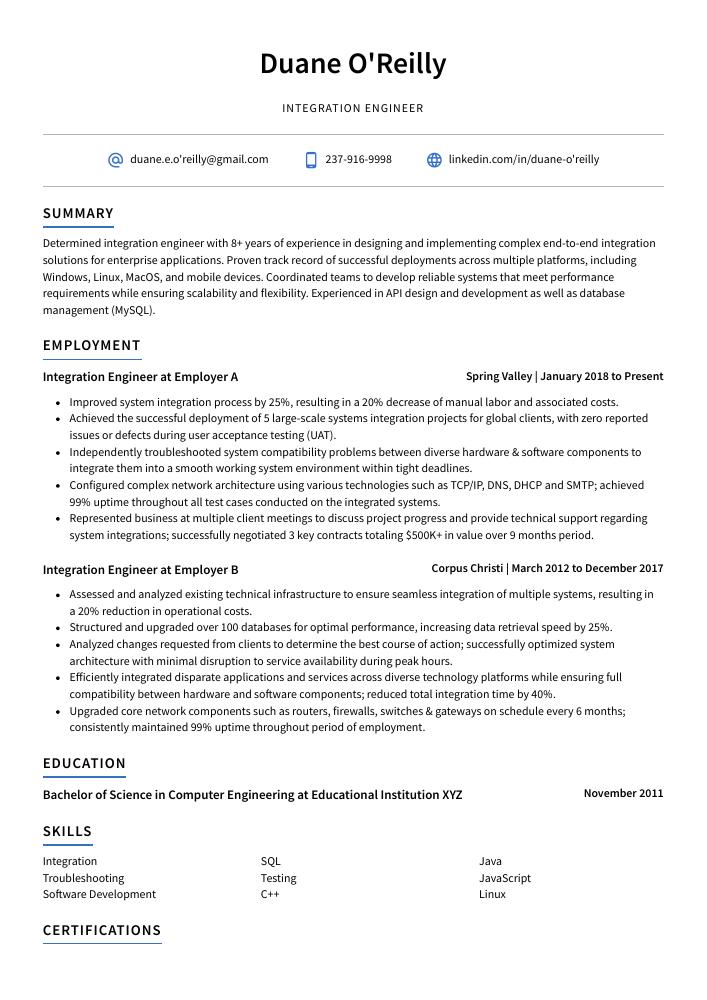Integration Engineer Resume Guide
Integration Engineers are responsible for designing, developing and deploying software solutions that integrate different systems. They work to ensure the smooth functioning of these integrated systems by testing them, troubleshooting issues and making necessary adjustments. Additionally, they configure system settings in order to optimize performance and provide technical support when needed.
Integration engineering is your specialty and employers need to know that. To make them aware of your technical abilities, you must write a resume that stands out from the crowd.
This guide will walk you through the entire process of creating a top-notch resume. We first show you a complete example and then break down what each resume section should look like.
Table of Contents
The guide is divided into sections for your convenience. You can read it from beginning to end or use the table of contents below to jump to a specific part.
Integration Engineer Resume Sample
Duane O’Reilly
Integration Engineer
duane.e.o’[email protected]
237-916-9998
linkedin.com/in/duane-o’reilly
Summary
Determined integration engineer with 8+ years of experience in designing and implementing complex end-to-end integration solutions for enterprise applications. Proven track record of successful deployments across multiple platforms, including Windows, Linux, MacOS, and mobile devices. Coordinated teams to develop reliable systems that meet performance requirements while ensuring scalability and flexibility. Experienced in API design and development as well as database management (MySQL).
Experience
Integration Engineer, Employer A
Spring Valley, Jan 2018 – Present
- Improved system integration process by 25%, resulting in a 20% decrease of manual labor and associated costs.
- Achieved the successful deployment of 5 large-scale systems integration projects for global clients, with zero reported issues or defects during user acceptance testing (UAT).
- Independently troubleshooted system compatibility problems between diverse hardware & software components to integrate them into a smooth working system environment within tight deadlines.
- Configured complex network architecture using various technologies such as TCP/IP, DNS, DHCP and SMTP; achieved 99% uptime throughout all test cases conducted on the integrated systems.
- Represented business at multiple client meetings to discuss project progress and provide technical support regarding system integrations; successfully negotiated 3 key contracts totaling $500K+ in value over 9 months period.
Integration Engineer, Employer B
Corpus Christi, Mar 2012 – Dec 2017
- Assessed and analyzed existing technical infrastructure to ensure seamless integration of multiple systems, resulting in a 20% reduction in operational costs.
- Structured and upgraded over 100 databases for optimal performance, increasing data retrieval speed by 25%.
- Analyzed changes requested from clients to determine the best course of action; successfully optimized system architecture with minimal disruption to service availability during peak hours.
- Efficiently integrated disparate applications and services across diverse technology platforms while ensuring full compatibility between hardware and software components; reduced total integration time by 40%.
- Upgraded core network components such as routers, firewalls, switches & gateways on schedule every 6 months; consistently maintained 99% uptime throughout period of employment.
Skills
- Integration
- SQL
- Java
- Troubleshooting
- Testing
- JavaScript
- Software Development
- C++
- Linux
Education
Bachelor of Science in Computer Engineering
Educational Institution XYZ
Nov 2011
Certifications
Certified Integration Engineer
International Association of Software Architects (IASA)
May 2017
1. Summary / Objective
Your resume summary/objective should be a concise, yet compelling snapshot of your experience and skills as an integration engineer. In this section, you should mention the systems and technologies you have worked with in the past (e.g., Salesforce), any certifications or awards that demonstrate your expertise in this field, and how you successfully implemented complex integrations for previous employers.
Below are some resume summary examples:
Proficient integration engineer with 5+ years of experience in developing and deploying custom integration solutions. Extensive knowledge in various technologies such as. NET, SQL Server, Java/J2EE, Web Services and SOA architectures. Proven track record of successfully integrating legacy systems into new applications to achieve business objectives efficiently. At XYZ, managed the successful migration from an on-premise system to a cloud-based platform resulting in cost savings of 20%.
Hard-working integration engineer with 5+ years of experience designing and building microservices-based integrations. Proficient in multiple development languages, including Java, JavaScript/NodeJS, Python and Groovy. Skilled at leveraging APIs to build custom solutions for customer needs. Seeking to join ABC Tech as an integration engineer where I can use my skills to enhance their product offerings and create user value across the board.
Amicable and experienced integration engineer with 10+ years of experience in the design, development, deployment and maintenance of enterprise-level software solutions. Experienced in working with multiple platforms such as J2EE and Microsoft. NET to integrate applications and services across heterogeneous environments. Skilled at troubleshooting complex technical issues and providing timely resolutions for customer satisfaction.
Committed integration engineer with 7+ years of experience developing and deploying complex integration solutions. Adept in using various software development tools, techniques, and platforms to build reliable applications for enterprise-level environments. Seeking an opportunity at XYZ Corporation to use my expertise in creating innovative integrations that optimize performance while ensuring high scalability and reliability.
Driven integration engineer with 5+ years of experience developing and managing complex systems integration projects. Skilled in analyzing client needs, mapping out solutions, and deploying best-in-class technology for a wide range of customers across industries. At ABC Solutions, achieved 25% improvement in customer satisfaction by streamlining data transfer between disparate systems.
Seasoned integration engineer with 8+ years of experience in designing and developing software solutions that integrate disparate systems. Proven ability to analyze complex problems, develop innovative solutions, and ensure successful delivery of projects within budget constraints. Seeking an opportunity to apply my knowledge and skillset at ABC Tech as a senior integration engineer.
Reliable integration engineer with 5+ years of hands-on experience in the integration, development and deployment of enterprise applications. Certified to use Java/J2EE technologies for a wide range of integration solutions. Seeking to join ABC Solutions as an Integration Engineer where I can utilize my expertise in developing innovative solutions that address business needs.
Detail-oriented integration engineer with 5+ years of experience developing, deploying, and maintaining enterprise-level integration solutions. Proven track record of delivering projects on time and on budget. Seeking to join ABC Tech where I can use my expertise in systems integration to help build innovative solutions for the company’s clients.
2. Experience / Employment
For the experience section, you should list your employment history in reverse chronological order, with the most recent job listed first.
When writing about what you did at each role, use bullet points to make it easier for the reader to take in your information quickly. When possible, include quantifiable results that demonstrate how successful you were in that position.
For example, instead of saying “Integrated multiple systems,” you could say “Successfully integrated 5+ software and hardware systems into a single platform which resulted in an 80% reduction of manual labor.”
To write effective bullet points, begin with a strong verb or adverb. Industry specific verbs to use are:
- Integrated
- Configured
- Automated
- Monitored
- Analyzed
- Optimized
- Developed
- Implemented
- Tested
- Debugged
- Troubleshot
- Resolved
- Documented
- Deployed
- Upgraded
Other general verbs you can use are:
- Achieved
- Advised
- Assessed
- Compiled
- Coordinated
- Demonstrated
- Expedited
- Facilitated
- Formulated
- Improved
- Introduced
- Mentored
- Participated
- Prepared
- Presented
- Reduced
- Reorganized
- Represented
- Revised
- Spearheaded
- Streamlined
- Structured
- Utilized
Below are some example bullet points:
- Implemented new software integration solutions for over 40 clients, resulting in increased system performance by 20%.
- Demonstrated advanced knowledge of APIs and data formats to facilitate seamless transfer of information between different systems and applications.
- Utilized object-oriented programming skills to customize existing software components as needed; reduced average development cycle time by 50 hours per project.
- Facilitated successful integrations with 3rd party vendors which enabled secure customer data exchange across multiple platforms without disruption or loss of quality assurance standards.
- Meticulously tested all newly integrated hardware/software configurations before releasing them into production environments, ensuring 100% uptime for customers worldwide during the first week after launch date each time.
- Prepared and tested software integration solutions for various projects, ensuring that coding standards and best practices were met; reduced debugging time by 40% on average.
- Accurately configured customer systems to enable delivery of integrations between applications within specified timelines; successfully completed over 30 integration projects in the last year.
- Optimized existing codebase with automated testing procedures and continuous monitoring tools resulting in a 15% reduction of overall development cost per project cycle.
- Revised system requirements documents to ensure they reflected current application functionality while minimizing risk factors associated with implementation; achieved 95+% accuracy rate across all revisions made so far this year.
- Compiled detailed technical specifications from user stories which enabled successful execution of integration processes without compromising performance metrics or security protocols; decreased lead times for product delivery by 25%.
- Integrated software systems for over 500 clients, resulting in an 18% increase in operational efficiency.
- Monitored system performance and identified software compatibility issues; implemented new solutions that improved overall stability by 20%.
- Expedited the integration process of 8+ applications to meet tight deadlines while maintaining a high level of accuracy and quality assurance standards.
- Substantially reduced troubleshooting time when integrating complex software projects by 35%, leading to cost savings of $8,000 within a single quarter.
- Resolved more than 100 technical support cases related to integration challenges with customers onsite or remotely via phone/email within 24 hours or less each time.
- Successfully integrated complex systems for 30+ applications, resulting in a reduction of costs by 25%.
- Participated in the design and testing of new integration solutions; developed automated scripts to enable efficient data exchange between multiple client databases.
- Reduced system downtime and support tickets by 15% through proactive monitoring & maintenance of integrations across various platforms including Salesforce, Oracle & SQL Server.
- Coordinated with stakeholders on requirements gathering and documentation related to each project; created comprehensive user manuals detailing processes and operations for future reference purposes.
- Troubleshot integration issues arising from compatibility or performance problems quickly using analytical skills and problem-solving techniques that resulted in an average response time of 2 hours per issue resolution.
- Deployed and configured multiple integration solutions for over 50 clients, resulting in an average of 25% improvement in system performance.
- Proficiently utilized various debugging tools and techniques to identify and resolve complex software issues within tight time constraints; decreased customer support requests by 30%.
- Debugged application code across a variety of programming languages such as Java, JavaScript and Python, ensuring that all client requirements were met effectively with minimal errors.
- Streamlined the existing API integration process across dozens of web applications through automated scripts built using Ruby on Rails; reduced manual labor hours by 40%.
- Presented architectural designs for new integrations to executive stakeholders at bi-monthly meetings; successfully obtained approval from 70%+ customers every quarter.
- Developed, tested and implemented integration solutions for 15+ applications, ensuring the seamless exchange of data between systems while improving end-user experience.
- Formulated a comprehensive set of standard operating procedures (SOPs) to streamline manual processes and automated daily tasks, resulting in a 40% reduction in system errors.
- Documented all project requirements and updates as well as software installation instructions with clear step-by-step guidance; decreased resolution time by 50%.
- Mentored junior engineers on best practices when developing integration solutions, leading to increased customer satisfaction scores from 6/10 to 8/10 within 3 months’ period.
- Diligently monitored system performance throughout deployment stages using various tools like Splunk & AWS CloudWatch; identified potential issues before they impacted production environment and enabled faster stabilization times during rollout phases (+75%).
- Reorganized and improved the integration process for 20+ applications, resulting in a 25% increase in system speed and scalability.
- Spearheaded multiple projects to integrate systems across departments, including developing API endpoints that enabled communication with external parties; reduced manual labor by 50%.
- Advised stakeholders on best practices regarding system architecture design while troubleshooting complex issues related to integration processes and resolving them within hours.
- Automated various integrations using script-based programming languages such as Python or JavaScript; automated tasks decreased setup time by 40%.
- Reliably managed full stack of application environments during project cycles, ensuring smooth transitioning between phases without any downtime or disruption of service delivery standards.
3. Skills
Even though two organizations are hiring for the same role, the skillset they want an ideal candidate to possess could differ significantly. For instance, one may be on the lookout for an individual with experience in integrating Salesforce and another for someone who can work with Oracle.
The skills section of your resume should be tailored to each job you are applying for, as this will help the employer’s applicant tracking system recognize that you possess the required qualifications. This is especially important if they use an ATS (applicant tracking system) because it scans resumes for certain keywords before passing them on to a human.
You can further elaborate on your skillset by discussing it in more detail in other areas such as the summary or experience sections.
Below is a list of common skills & terms:
- Active Directory
- Agile Methodologies
- AutoCAD
- Business Analysis
- C
- C#
- C++
- CSS
- Computer Hardware
- Data Analysis
- Databases
- Electronics
- Engineering
- HL7
- HTML
- Healthcare
- Healthcare Information Technology
- Integration
- Java
- JavaScript
- Linux
- MATLAB
- Manufacturing
- Microsoft SQL Server
- MySQL
- Networking
- Oracle
- PHP
- Process Improvement
- Programming
- Python
- Requirements Analysis
- SDLC
- SOLIDWORKS
- SQL
- Security
- SharePoint
- Software Development
- Software Documentation
- Software Project Management
- System Administration
- Systems Engineering
- TCP/IP
- Team Leadership
- Teamwork
- Technical Support
- Telecommunications
- Testing
- Time Management
- Troubleshooting
- Unix
- Visio
- Web Development
- Windows
- Windows Server
- XML
- jQuery
4. Education
Including an education section on your resume is a personal decision. If you are just starting out and have no prior experience, it’s important to include the education section below your resume objective. However, if you have extensive work experience in the integration engineering field that should be highlighted instead of mentioning educational background, then feel free to omit this part of the resume altogether.
If an education section is included, try to mention courses relevant to integration engineering such as software development or system design that demonstrate your knowledge and skills for this role.
Bachelor of Science in Computer Engineering
Educational Institution XYZ
Nov 2011
5. Certifications
Certifications demonstrate to potential employers that you have the knowledge and skills necessary for a given field. They are also proof of your commitment to professional development, showing that you take initiative in keeping up with industry trends and best practices.
If there is an applicable certification related to the job position, be sure to include it on your resume as this will give you an edge over other applicants who do not possess such credentials.
Certified Integration Engineer
International Association of Software Architects (IASA)
May 2017
6. Contact Info
Your name should be the first thing a reader sees when viewing your resume, so ensure its positioning is prominent. Your phone number should be written in the most commonly used format in your country/city/state, and your email address should be professional.
You can also choose to include a link to your LinkedIn profile, personal website, or other online platforms relevant to your industry.
Finally, name your resume file appropriately to help hiring managers; for Duane O’Reilly, this would be Duane-O’Reilly-resume.pdf or Duane-O’Reilly-resume.docx.
7. Cover Letter
Writing a cover letter is an important part of the job application process. It is a chance to show potential employers why you are the right person for the role and make yourself stand out from other applicants.
Cover letters should be between 2-4 paragraphs long, separate from your resume, and provide more detailed information about who you are as a professional. They also allow recruiters to gain further insight into what makes you uniquely qualified for the position and how you could add value to their team or organization.
Below is an example cover letter:
Dear Burnice,
I am writing to apply for the Integration Engineer position at XYZ Corporation. With seven years of experience in systems integration and a strong background in software development, I believe I would be a valuable asset to your team.
In my current role as an Integration Engineer at ABC Corporation, I am responsible for designing and implementing integrations between multiple software applications. My work involves developing custom scripts and connectors to facilitate data exchange, as well as troubleshooting any issues that arise during testing or deployment. In addition to my technical skills, I have also been praised by my managers for my ability to effectively communicate with both technical and non-technical staff.
I am confident that I can bring the same level of skill and dedication to XYZ Corporation if given the opportunity. The challenges involved in integrating complex systems are what motivate me, and I thrive in fast-paced environments where there is always something new to learn. Enclosed is a copy of my resume which provides additional details about my qualifications; please do not hesitate to contact me if you have any questions or require further information.
Thank you for your time and consideration; I look forward to hearing from you soon about this exciting opportunity.
Sincerely,
Duane
Integration Engineer Resume Templates
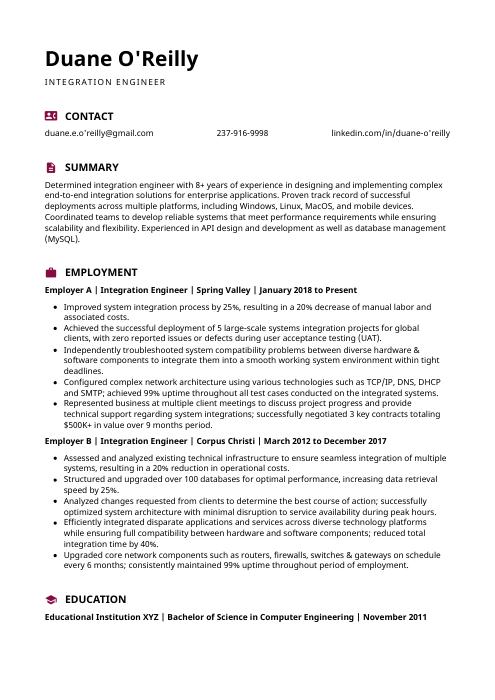 Hoopoe
Hoopoe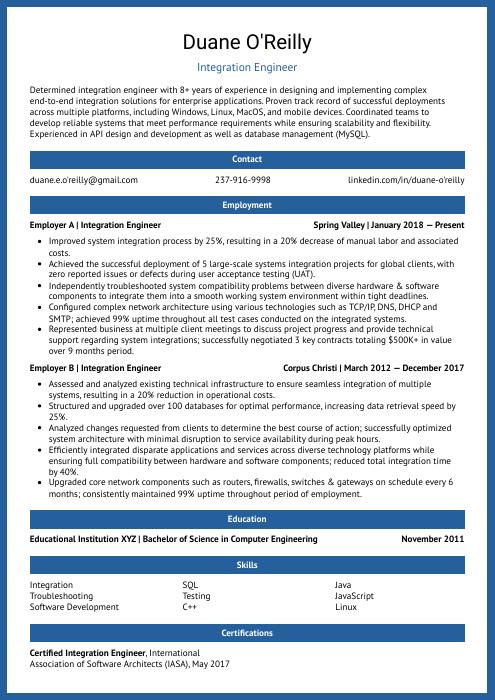 Ocelot
Ocelot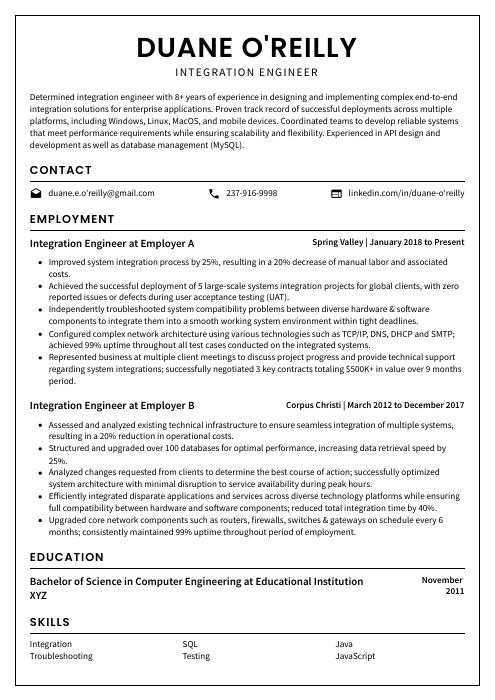 Cormorant
Cormorant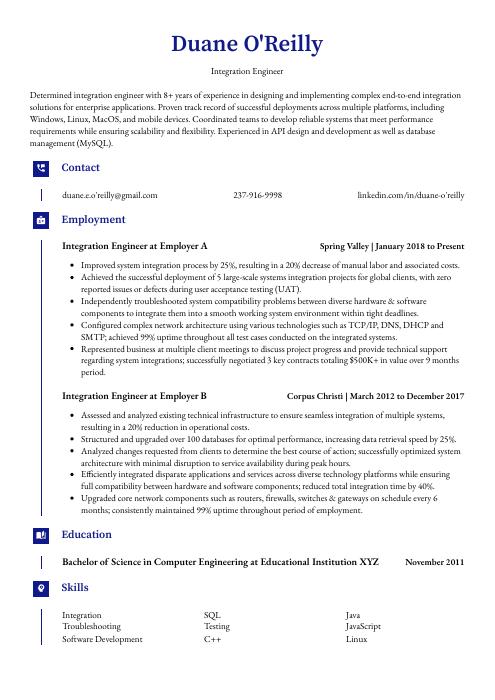 Gharial
Gharial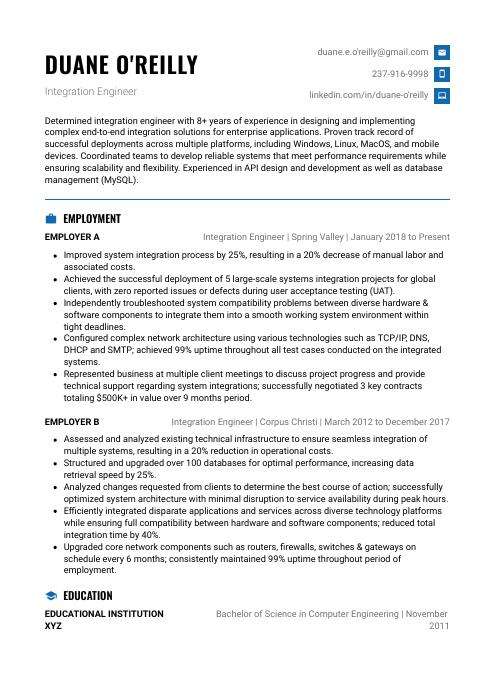 Echidna
Echidna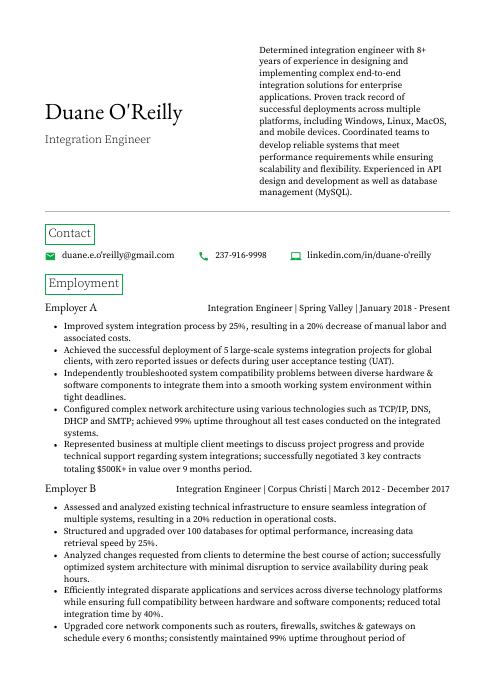 Quokka
Quokka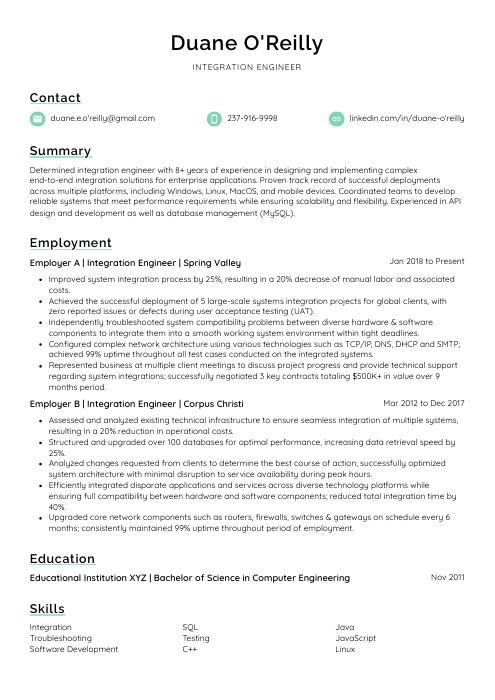 Lorikeet
Lorikeet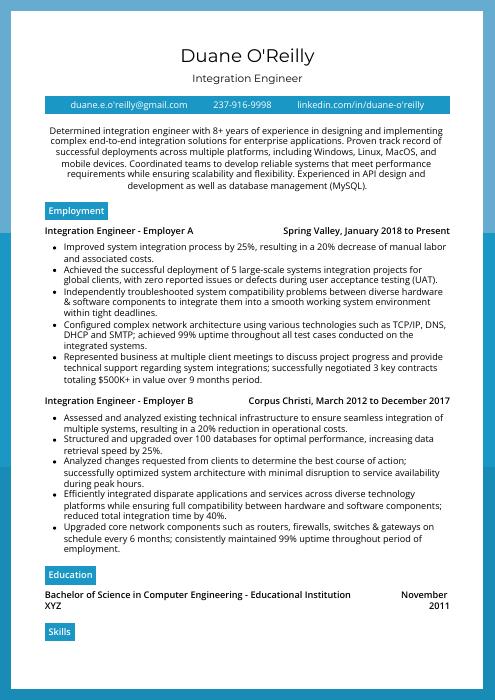 Rhea
Rhea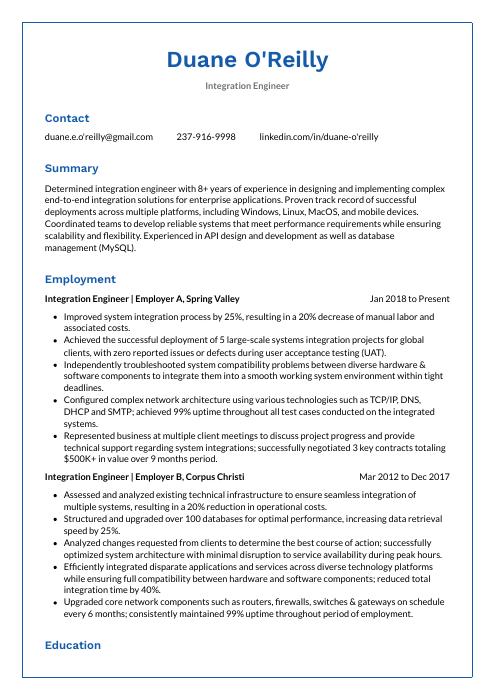 Markhor
Markhor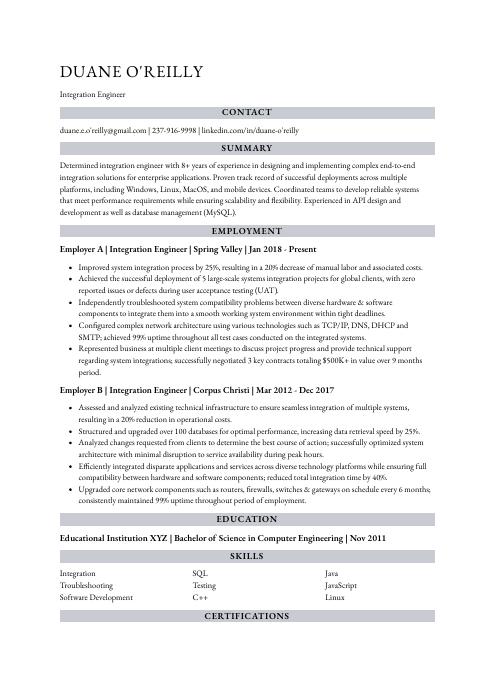 Numbat
Numbat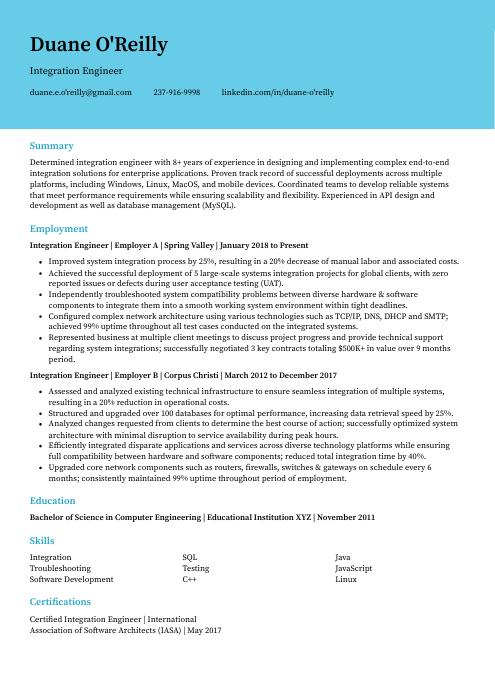 Dugong
Dugong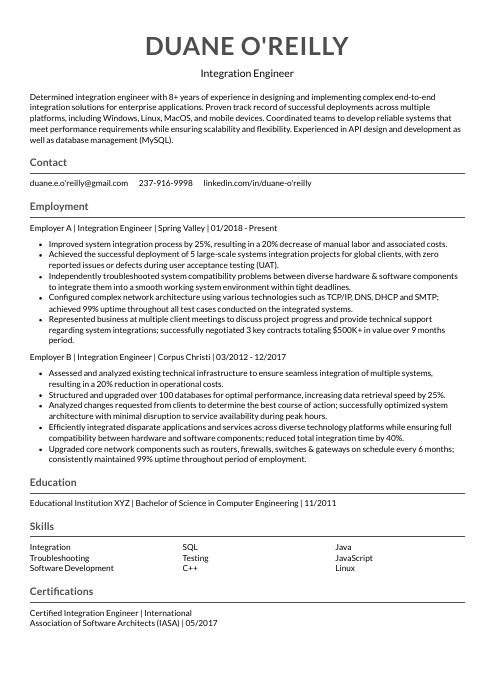 Indri
Indri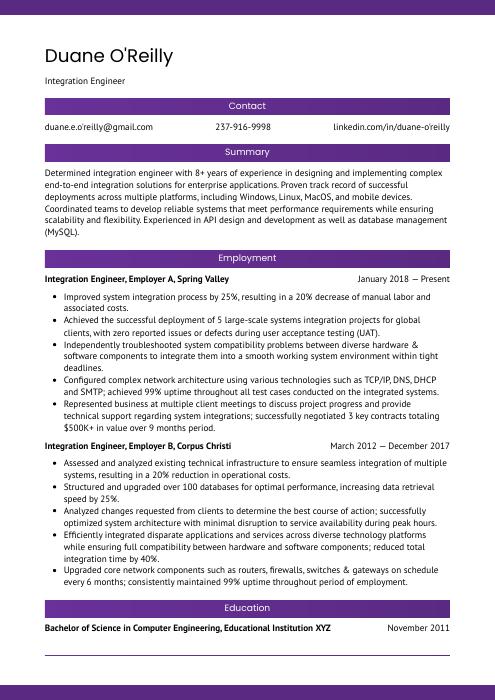 Jerboa
Jerboa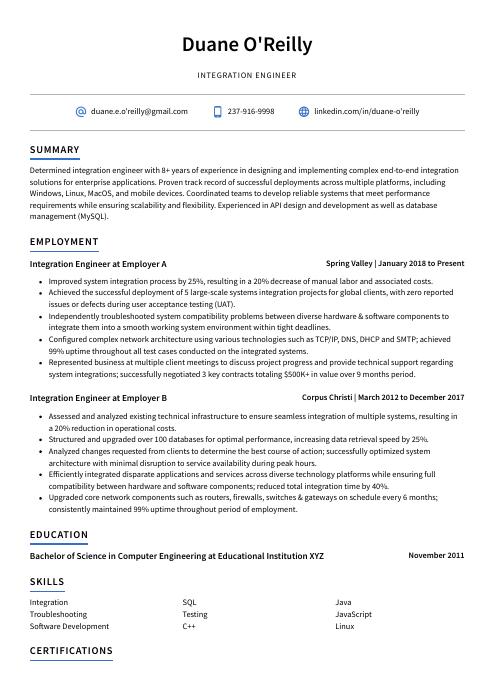 Axolotl
Axolotl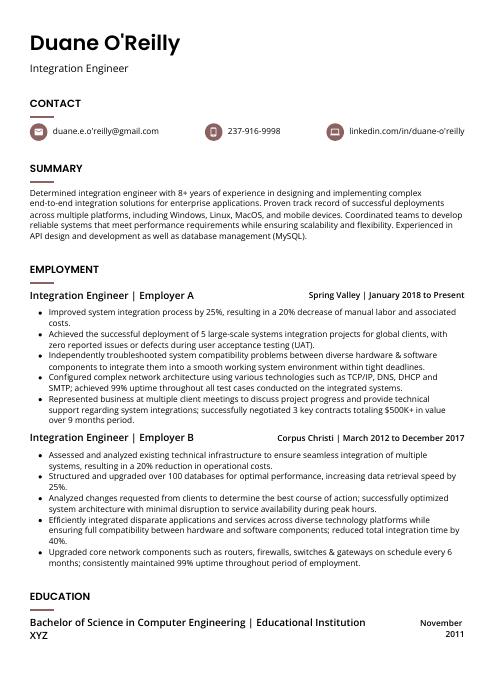 Fossa
Fossa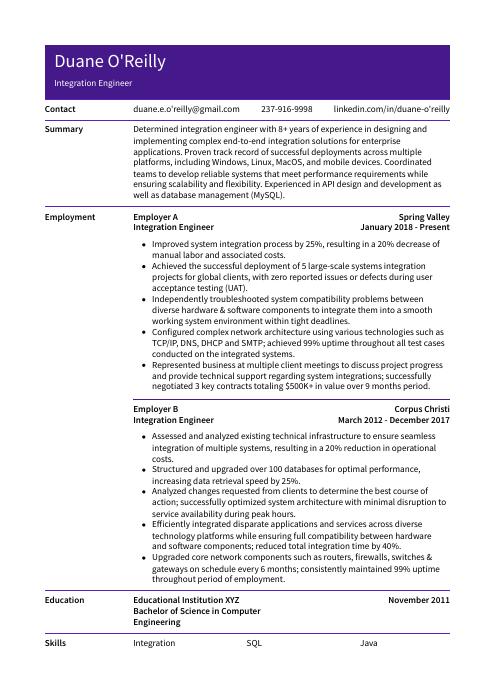 Pika
Pika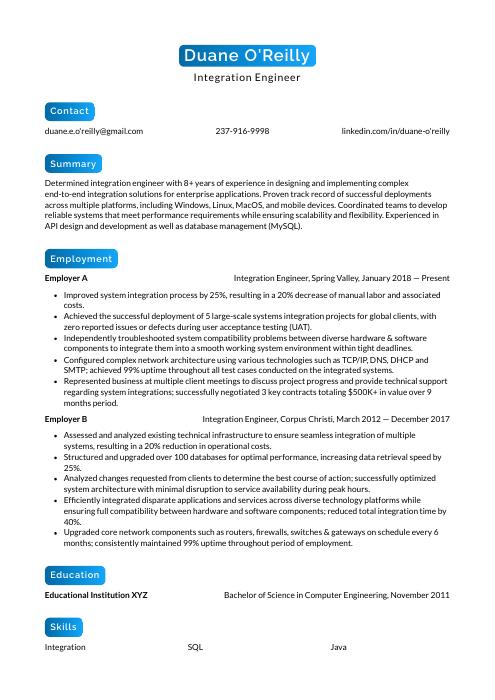 Kinkajou
Kinkajou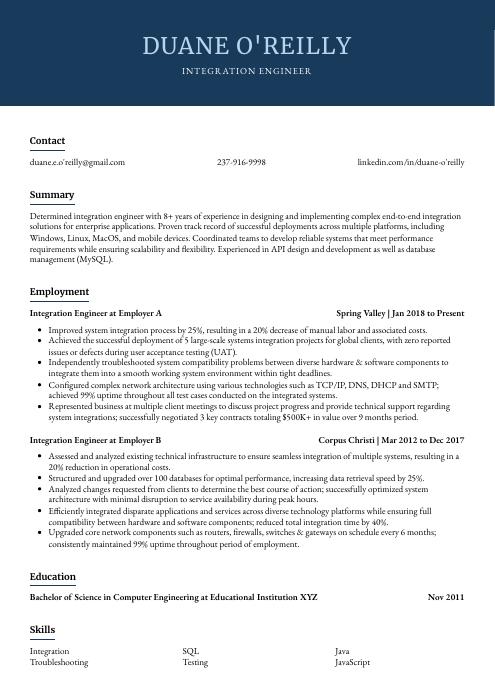 Bonobo
Bonobo Rezjumei
Rezjumei
